Steak and kidney puddings don't often appear on menus these days. For someone who, since eating a revelationary pud at an unprepossessing pub somewhere in the home counties has been seeking them out with the zeal of a convert, this is a great shame. That said, it's also one of the very best reasons for making them at home.
The other is that the pudding, in the truest sense of the word, is one of the few dishes that this country can fairly claim as its own – indeed, a 17th-century French visitor was move to write "blessed be he that invented pudding, for it is a manna that hits the palates of all sorts of people; a manna, better than that of the wilderness, because the people are never weary of it. Ah, what an excellent thing is an English pudding!" And from a Frenchman, that's basically an admission of culinary genius.
Although the pudding has a long and noble history (according to the Oxford Companion to Food it's able to trace its lineage back to the imperial Roman sausage), the modern boiled pudding only appeared on the scene with the invention of pudding cloth in the 17th century, and basins have only come into widespread use in the last hundred years. And what of that great combination, steak and kidney? Jane Grigson tells us that Mrs Beeton was the first to put the two together under a suet crust in 1861, in a recipe sent to her by a reader in Sussex, a county that "had been famous for its puddings of all kinds for at least a century".
It became a classic for good reason: the earthy taste of the kidney, so rarely eaten in other contexts these days, adds richness to the savoury flavour of the beef, and both create a delicious gravy that soaks the inside of the light, spongy suet pastry to create a dish so good, it's almost worth delaying spring for.
The beef

Although I've come round to kidneys in recent years, their assertive flavour means that I still prefer to make steak the star of this dish. But what kind of steak? Jane Grigson calls, extravagantly in my view, for rump (although this is, in fact, obedient to Mrs Beeton's version), Nigella Lawson for stewing steak (generally, according to Delia, taken from the neck of the animal), and Gary Rhodes for braising steak, for which I use chuck. (Constance Spry just asks for "beefsteak", for which I also use stewing steak, possibly unwisely – of which more later.) The rump, although worryingly rubbery halfway through cooking, relaxes, but it's dry in comparison with the neck and chuck, both of which fall apart under my fork after 4 hours' cooking.
Kidneys
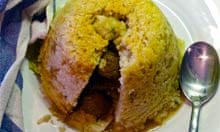
I'd naively assumed that the organs in question would be bovine, but in fact, Nigella and Gary Rhodes both suggest using lamb's kidneys. Constance Spry goes for ox kidney, and Jane Grigson suggests ox or veal. It seems to be largely a question of tolerance – the lamb kidney has a delicate flavour, which makes its presence in the pudding largely textural. Veal is more assertive, while the ox kidney crosses the line into what could kindly be described as "robust". If you're a true kidney aficionado, this is the one for you, but I prefer them to take a slightly more retiring role, so I've chosen the subtler but still beefy veal offal (and opted for an ethical rose veal kidney).
Suet
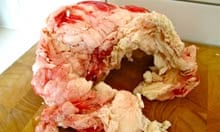
The thing that raises the pudding head and shoulders above all other pie pretenders is, in my opinion, suet. This thick, creamy fat encases the kidneys, and gives the pastry a surprising lightness thanks to its high melting point – the shell has already set by the time the suet dissolves, leaving a pattern of tiny air holes in its place.
Fresh suet, however, as demanded by Gary Rhodes, proves difficult to obtain. Butcher after butcher shake their heads in apology – apparently the stuff is now stripped from the carcass at the slaughterhouse to be sold more profitably elsewhere (if anyone knows anything more about this, I'm intrigued).
Eventually I manage to get some on special order from Adam Perry Lang's Barbecoa – a great pinkish white cloud of fat and sinew which, once carefully sorted and chipped, gives a remarkably rich, tasty result. If you can't find fresh suet, you can use the processed stuff which is available in the baking section of all supermarkets. The flavour won't be quite as good, but you'll end up with the correct texture.
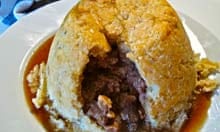
Gary flies in the face of convention by demanding his suet pastry must be rested before use (the Leiths Cookery Bible cautions it's important to cook the pastry as soon as possible after making it, while the raising agent is still active) and, although I love the taste of his pastry, it's more flaky than fluffy.
Nigella nobly specifies vegetarian suet, on the basis that "I don't like eating meat products whose derivation I do not know." Constance and Jane simply call for suet, so for their recipes, I use the ready-shredded stuff of dubious origin but cheerful packaging. Nigella's pastry is excellent, but Jane Grigson's is lighter – and once I discover that many vegetarian versions are made from palm oil, it starts to look slightly less virtuous, however much lower its fat content. For flavour, I'm going to use Gary's fresh suet, but stick to Nigella and Jane's cooking instructions.
Cooking methods
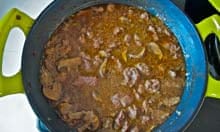
The traditional method of cooking any kind of pudding is, of course, boiling or steaming, but most of my recipes include a lengthy braising stage before the meat gets anywhere near its suet pastry jacket – Jane Grigson says that she believes one gets a "better, less sodden crust" this way, but I think the flavour of the meat is immeasurably improved too. The raw beef that goes into Constance Spry's pudding comes out gloopy with flour, and tough as a Victorian boarding school, which makes me wonder whether perhaps she intended a more forgiving cut than neck to be used.
Pre-cooking also allows you to brown the meat, which automatically gives the gravy a head start, as well as beginning the tenderising process – no wonder the stewing steak in Nigella's pudding is so much silkier than that in poor old Constance's.
Other ingredients

Constance also lets herself down with the plainness of her filling which adds only a few chopped herbs to Mrs Beeton's spartan original list of meat, seasoning and water. Although I know simplicity is supposed to be a virtue in the kitchen these days, it would take a more delicate palate than mine to believe that water makes a tastier gravy than Nigella's mixture of beef stock and stout, which is richly savoury and gorgeous.
Jane Grigson suggests a mix of beef stock and red wine, which, although equally tasty, doesn't seem quite right – this should be a purely British dish. The same goes for Gary's garlic: it's just not necessary here. I like the sweetness of the caramelised carrots and onions in his dish though: a delicious contrast to the savouriness of the beef.
Mrs Grigson also suggests adding oysters to the pudding – a time-honoured combination with beef, but one which I eschew as not strictly on topic. Nigella's nod to the same idea with oyster sauce, however, makes the grade, but I'm not convinced, clever as the idea is, that it makes much difference. Thinking back to my beef stew and dumplings recipe, I think the same rich meatiness can be achieved with a combination of stout and stock.
Suet pastry has a rich, but not particularly distinctive flavour, so it's fair game for a few complementary flavours – Jane Grigson's chopped thyme and Nigella's mustard powder help to make it tasty enough to eat on its own. Not that I have, obviously. Why would you when there's gravy this delicious to douse it in?
Perfect steak and kidney pudding
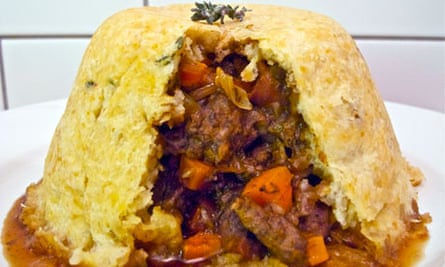
Serves 4
1 tbsp plain flour
400g chuck or stewing steak, cut into chunks
150g rose veal kidney
1½ tbsp beef dripping or oil, to cook
1 onion, thinly sliced
1 carrot, peeled and diced
1 bay leaf
Small bunch of thyme, leaves picked
150ml stout
150ml beef stock
For the pastry:
250g plain flour
2 tsp baking powder
¼ tsp salt
½ tsp English mustard powder
125g chopped suet
3 stalks fresh thyme, leaves finely chopped
Oil, to grease
1. Heat the dripping in a large pan and cook the onions and carrots with the herbs until they are beginning to caramelise. Remove from the pan and set aside. Season the flour well with salt and pepper, and toss the steak and kidney in it to coat. Add more fat to the pan if necessary, then brown the meat in batches, so it doesn't cook in its own juices.
2. Pour in the stout and scrape any beefy floury bits from the bottom of the pan, then add the stock, the vegetables and all the meat, bring to a simmer, and partially cover and simmer gently for 1¾ hours until all is tender. Season to taste and allow to cool.
3. Two hours before you want to eat, sift the flour and baking powder into a mixing bowl and add the salt and mustard powder. Rub in the suet briefly to mix, then add the thyme and enough cold water to bring it to a firm dough. Pinch off a quarter of the dough and set aside, then roll out the rest to about ½ cm thick. Grease a 1 litre pudding basin generously, and use the pastry to line it, being careful not to stretch it.
4. Fill the pastry with meat and gravy, stopping about 2cm from the top, and then roll out the lid and stick it on with a little cold water. Cover the basin with foil, leaving enough slack for the pastry to rise, and fashion a handle out of string to lift the basin out of the water.
5. Put the pudding in a large pan half-filled with boiling water, cover and simmer for 1½ hours, checking the water level regularly and topping up with more boiling water as necessary. Turn out and serve immediately.
Is the great British pudding a national institution, or were you glad to see the back of them when Heartbeat finally ended? What other wonders come encased in suet pastry (and while we're at it, can anyone explain where all the suet's gone?), and how else do you like your kidneys?
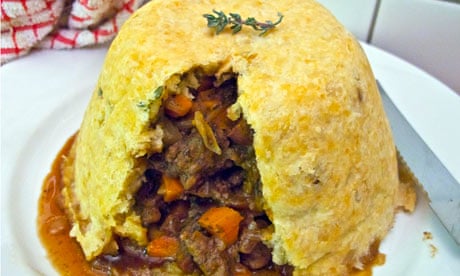
Comments (…)
Sign in or create your Guardian account to join the discussion